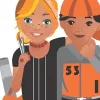Take a look inside 5 images
KidsThinkDesign
Pros: Clean design and sophisticated resources make for a unique collection of projects to get kids thinking and innovating.
Cons: An online community space where kids could share creative ideas would boost engagement, especially for older kids.
Bottom Line: A go-to site for teachers looking for well-presented project ideas; kids will need opportunities to share work locally.
Art and design teachers will be most interested in using KidsThinkDesign as a way to integrate skills like mapping, art and visual design, written expression, and speaking into their curriculum. Start with the World of Design project for your whole class; kids can develop observation skills while they generate ideas. Moving forward, have students work in groups to select one of the disciplines for a second project. A culminating assessment could take the form of an interactive presentation, or could include make-it-take-it types of activities.
Teachers will likely want to add an overview of expectations and deadlines for formative assessments, though many of these DIY projects could stand on their own. The site's biographies of current and historical creators could be integrated with an existing ELA or social studies curriculum. A good number of the activities here will appeal to a broad spectrum of learners; whether your students are advanced readers, struggling readers, or ELLs, many kids have a strong preference for just this kind of active, project-based learning.
The KidsThinkDesign website walks the walk with easy navigation and clean design throughout. Kids can easily find inspiration for projects in a number of areas: fashion, graphics, interiors, books, products, film and theater, architecture, animation, and the environment. Within each area, explorations offer information under the headings Product Design, Meet a Designer, Think Like a Designer, Design a Project, and Learn More. Kids can peruse mini-features, like how color impacts purchasing decisions. Or they could explore (or even print out) DIY projects ranging from assembling models to conducting a land use survey.
While the site's Store tab redirects to Amazon.com, and there's a sponsoring vendor for art supplies, both are incorporated tastefully. The site asks kids to self-report their birthday and give a parent's or teacher's email address for design submissions. There are also links to other sophisticated design content on the Web, like the National Building Museum, a Frank Lloyd Wright website, and the Design Dossier.
KidsThinkDesign provides an expansive experience in design and style -- the experience is easily digestible for kids and teens with a range of backgrounds, learning needs, and reading levels. Large text, color-coded pages, meaningful icons, and provocative images are carefully assembled to ignite kids' imagination, catalyze creativity, and inspire throughout. Each project comes with a list of necessary supplies, very clear step-by-step instructions, sample images, and background information.
The first project in the World of Design section leads kids though the creation of a design map in their local area. Kids will observe and note unique design features (right down to pastries in a shop window) and then synthesize their findings on a 3-D, hand-drawn, or computer-rendered map. While the site accepts kids' design submissions, there aren't any available for viewing. An expansion to include more user-generated content and collaboration would be nice. Also, regular site updates with newer content would help boost engagement. Nevertheless, the site remains a valuable teaching resource overall.












